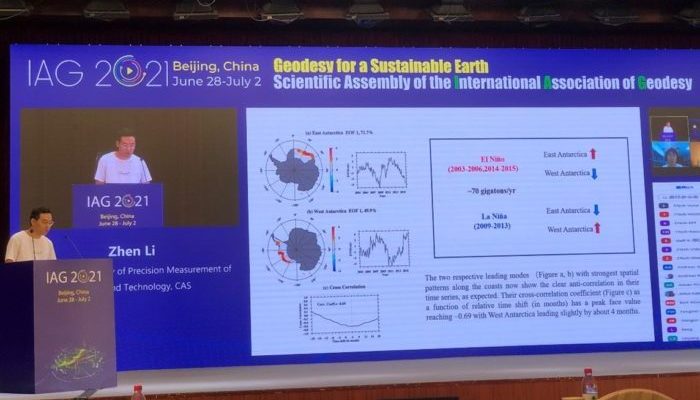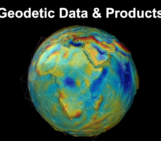
With the COVID pandemic still ongoing, many conferences have been taking place online or have opted for a hybrid format, with combined on-site and online program parts. To many of us this still a rather new experience, so we decided to share some of the impressions we gathered in the hybrid meetings we attended so far.
At the beginning of July, the International Association of Geodesy (IAG) Scientific Assembly (SA) themed “Geodesy for a Sustainable Earth” was held in a hybrid format for the first time. The on-site part of the conference took place at the China Surveying and Mapping Mansion in Beijing, China. The hybrid format had the side-effect that this year’s IAG SA had the most attendees by a large margin, with close to 1300 registered participants compared to a couple of hundreds in the last years. About 10% of those were on-site registered participants who followed the presentations at the conference venue. The session format was much like this year’s EGU General Assembly, with shorter pitch presentations followed by a discussion afterwards.
How did attendees experience such a hybrid conference format? Andreas Kvas and Zhen Li share their impressions from an online and on-site point of view.
Attending a hybrid meeting online
As a remote attendee, this year’s IAG was very much like an online conference. As presenter and session chair I got a technical primer in the week leading up to the conference to make sure the session runs smoothly. This was a genuinely good idea and certainly helped the convers and chairs to manage the sometimes very intense schedule. Oral and poster sessions were running in parallel in different Zoom channels which made hopping between sessions quite easy compared to switching conference rooms. I certainly joined more presentations and discussions than I would have on-site, which was a plus.
During the opening ceremony it was refreshing to see people giving the keynote lectures behind a speaker’s desk in conference hall. This was a welcome contrast to the office or virtual beach backgrounds of the online meetings during the last year. The integration of the on-site talks with the online platform worked very well, with seamless discussions being possible. In preparation of my talk, I recorded and uploaded a video of my presentation before the conference to make sure that if something goes wrong with my internet connection, session attendees still get to see my contribution. While it was quite a bit of work to get the video done, it was certainly worth it because then I was able to just sit back during the session and focus on the other interesting talks.
As with all online meetings, a major challenge is to fully focus on the conference. Since you are sitting behind your desk, working through your emails, and grading practicals is just very tempting. To me, this is the biggest challenge when attending online and something I have to work on in the future. Overall, the conference was a nice experience and very valuable for scientific exchange. However, I missed the interactions with colleagues during the coffee breaks which are difficult to make happen in an online and hybrid setting (gather at this year’s EGU General Assembly being a notable exception). The possibility to take part in the conference from anywhere in the world without expensive and polluting air travel certainly made up for it.
Attending a hybrid meeting on site
I felt very lucky to be able to attend this year’s scientific assembly on-site, considering the ongoing global COVID pandemic. This was my first time to join the IAG meeting, so I was really excited when saw the notification of abstract acceptance that I was assigned to give an oral presentation. Even though I was going to attend the meeting in person, I uploaded a video of my presentation a week in advance, in case for anything unexpected happened and I would not be able to be present at the meeting.
I arrived in Beijing a day early, to get settled in and check out the conference venue. Although I have prepared my presentation for a long time, on the day of my presentation I still felt quite nervous because it was also my first time speaking to an international audience in English. There were only five minutes scheduled for each presentation, so I had to simplify my speech to focus on the main points, which was quite the challenge for me. As you can see in the picture, the integration of the online audience worked quite well and there was a lively discussion after the talks. We could share our questions under the Zoom Q&A section, and I could directly message someone if I had any questions. I also could just raise my hand and then the section chair will give me few minutes to have an online discussion. So, it was easy for me to connect with online participants even though some connection problems were a minor inconvenience. During the discussion, the session chair helped me to translate some of the audience’s questions and I was happy with how the session went.
To me, the greatest strength of the on-site meeting was that it opened more opportunities to discuss my research with others, which I found very interesting and helpful. The scientific assembly was certainly an impressive and valuable experience for me, and I am looking forward to the next IAG scientific assembly, in whichever form it might be held.
Conclusions
We hope that these impressions gave you an idea on how a hybrid conference feels like, depending on whether you attend online or on site. The hybrid format has some key advantages like eliminating the need to travel and from our experiences so far it improves the accessibility and the inclusiveness of conferences leading to a more diverse conference environment. We believe this format is here to stay for the foreseeable future and are very much looking forward to seeing how it evolves with time.




Balaji Devaraju
Scientific assemblies like these should definitely be hybrid in the future as we have the enabling technology now, because it just allows researchers from all the countries irrespective of their income levels to participate and share their research. I hope EGU becomes hybrid forever!